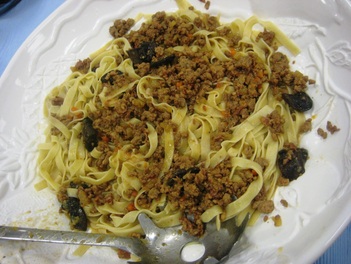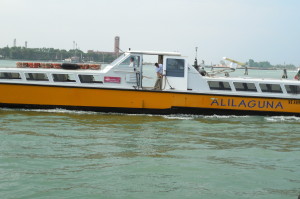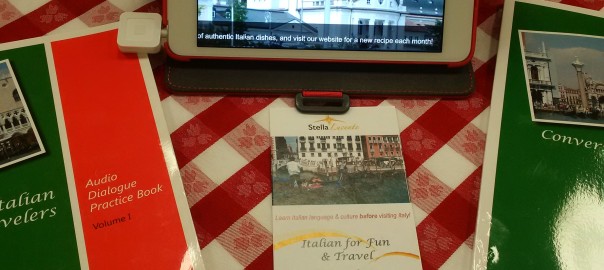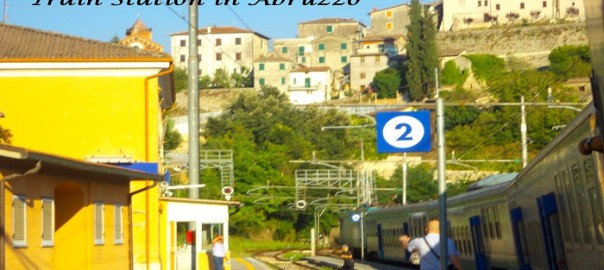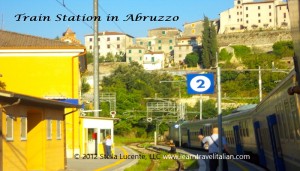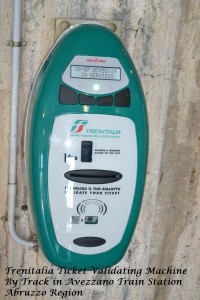Italian Sauce Recipe: Authentic Family-Style Bolognese Meat Sauce
Pasta alla Bolognese—pasta with everybody’s favorite meat sauce! And so easy to make… in one pot!
Italian Sauce Recipe: Bolognese Meat Ragù
This famous Italian sauce from the city of Bologna is actually a “ragù” (similar to the French “ragout”) because all of the ingredients are gradually combined and then simmered in a large saucepan for hours, until the flavors have beautifully melded and a thick sauce is created. Pair this delicious sauce with thick spaghetti or tubular macaroni that has ridges for the sauce to cling to. For a special dinner, this sauce is wonderful with homemade wide-ribbon pasta, such as tagliatelle or pappardelle. And remember, a little sauce goes a long way in Italy—a generous ladle of sauce on top of a nest of pasta in each plate makes a wonderful meal—top with freshly grated Parmesan cheese and enjoy! —Kathryn Occhipinti
Ingredients
(Serves 4 with 1 lb. of pasta)
3 Tbsp butter (plus more to finish sauce at end if desired)
2 Tbsp olive oil
½ cup chopped pancetta or ¼ cup chopped bacon
1 medium onion, chopped finely
1 stalk of celery, chopped finely
1 carrot, peeled and chopped finely
¾ cup ground beef
¾ cup ground pork
¼ cup ground Italian sausage (about 1 sausage removed from casing)
¾ cup dry white wine
1½ cups beef stock
4 tsp tomato paste
¼ cup whipping cream
Optional:¼ lb. cremini mushrooms, quartered and sautéed in 3 Tbsp olive oil and 1 Tbsp butter
Procedure
Heat 3 Tbsp of butter with 2 Tbsp of olive oil in a large skillet over medium heat.
Add the finely chopped onion, celery, and carrot, and cook with a pinch of salt until vegetables have softened.
Add the chopped pancetta or bacon and cook to render out the fat. Remove meaty parts of bacon.
Add the ground beef, ground pork, and Italian sausage meat, and stir with a wooden spoon to break up meat as it browns.
Add dry white wine and raise heat to high to boil off.
Mix a little of the beef stock with the tomato paste to thin, and then stir into the skillet with the other ingredients.
Season with salt and pepper to taste.
Add ¼ cup of the beef stock and cover the skillet.
Cook over medium-low heat for an additional 1 to 1½ hours, stirring intermittently and adding more stock gradually to keep the meat moist.
All the ingredients should come together to form a gravy-like sauce, or ragù.
Optional: While the meat ragù is cooking, quarter and sauté the mushrooms in a separate small frying pan in 1 Tbsp butter and 3 Tbsp olive oil and reserve.
To complete the sauce, remove the ragù from the heat, stir in the mushrooms and their juices, and then stir in the whipping cream.
Add additional tablespoons of cream and 1–2 Tbsp of butter as desired.
Serve immediately, with a generous ladle of sauce in the center of each plate of pasta.
(Leftover sauce can be stored in the refrigerator or for longer periods in the freezer. Add a little water to the sauce as needed and reheat over low heat.)
—Adapted from the cooking classes given by the Italian-American Society of Peoria, by Kathryn Occhipinti

Available on amazon.com and Learn Travel Italian.com
Kathryn Occhipinti, MD, is the author of the
Conversational Italian for Travelers
series of books and a teacher of
Italian for travelers to Italy in the Peoria and Chicago area.
“Everything you need to know to enjoy your visit to Italy!”
Join my
Conversational Italian!
Facebookgroup
and follow me on
Twitter
at
StellaLucente@travelitalian1
and start to
learn Italian
today for
FREE
!
Conversational Italian! Facebook Group
Tweet @travelitalian1 for Stella Lucente Italian
YouTube videos
to learn Italian
are available from © Stella Lucente, LLC.
Learn Conversational Italian.
More information on and photographs of Italy can be found on
Facebook Stella Lucente Italian
and
Pinterest Stella Lucente Italian
.
Facebook Stella Lucente Italian
Pinterest Stella Lucente Italian
Visit
learntravelitalian.com/download.html
to purchase/download
Conversational Italian for Travelers
and find more interesting facts and helpful hints about getting around Italy!
Learn how to buy train tickets online, how to make international and local telephone calls, and how to decipher Italian coffee names and restaurant menus, all while gaining the basic understanding of Italian that you will need to know to communicate easily and effectively while in Italy. —From the staff at Stella Lucente, LLC
Italian Sauce Recipe: Authentic Family-Style Bolognese Meat Sauce

